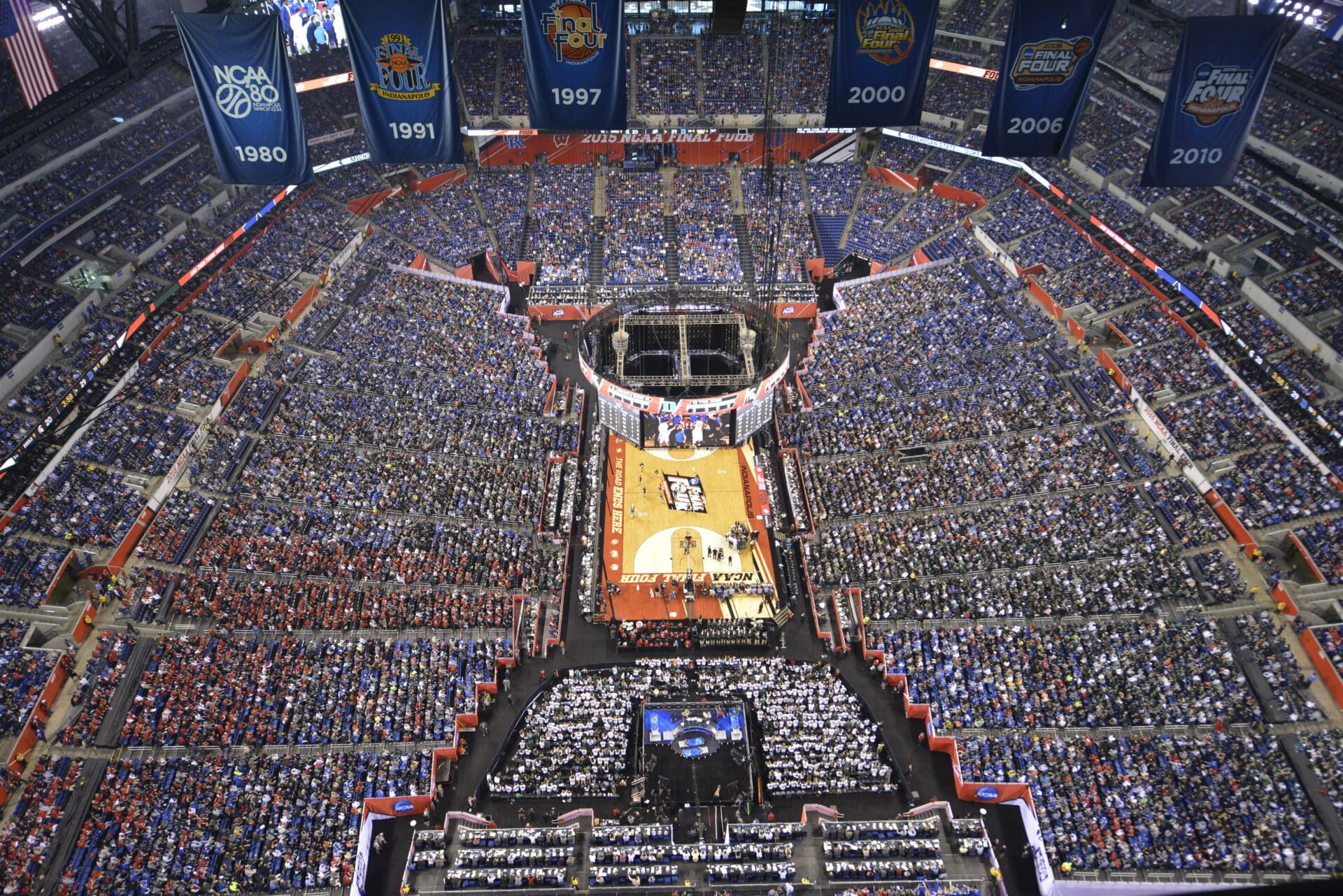
Field-Side: The NCAA can bring in up to 30,000 temporary seats for Final Four stadium games, as pictured at the 2015 event at Lucas Oil Stadium in Indianapolis. (©️Bo Baumgartner/Populous)
If you are looking for a Final Four floor seat, the NCAA has 30,000 of them.
In order to meet the demand for the NCAA’s annual high-stakes showdown known as the Final Four, the organizing body selects venues across the country that are built for field goals rather than free throws.
To help create a consistent experience for attendees, the NCAA brings their own seats to the party.
That seating system consists of adjustable riser decks that allow the NCAA to go into any venue and create the same — or nearly the same — seating configuration for events.
“If you are sitting in Row 20 in Indianapolis one year for a Final Four and you go the next year to another city, that Row 20 seat at mid-court is almost identical, if not identical, in sight lines and everything,” explained L.J. Wright, director of men’s basketball championships for the NCAA.
It’s not completely seamless. To accommodate the additional seating, stadiums sometimes need to remove seats and handrails. In newer facilities Wi-Fi systems, which may be under seats or attached to aisle handrails, may need to be reconfigured so the signal isn’t obstructed. The riser decks can be a level platform or tiered as they extend into the stands. It is the same system used to elevate the court exactly 29 inches, because at 30 inches some states would require a ball-blocking handrail.
Every detail fine-tuned over time is linked back to the man regarded as the Father of the Final Four, longtime NCAA staffer Tom Jernstedt, who retired in 2010 after taking the event from arenas to then half stadium bowls configurations to the mid-field presentation you see today.
“Because of the demand, he saw this potential opportunity to utilize all the resources that are in a stadium and provide more access to the games,” said Wright, who joined the NCAA in 2002. Jernstedt died in 2020.
To design the system, the NCAA worked with Dallas-based architectural firm HKS, who was building Lucas Oil Stadium in Indianapolis at the time, and stadiums including NRG Stadium (then Reliant Stadium) in Houston, Texas, which is the site of the 2023 NCAA Final Four April 1 and 3.
“Because the Houston Livestock Show and Rodeo put a large octagon video board over the top of their event and field, they said, ‘We already do this sort of thing. Come out and take a look,” Wright recalled. “So, we went out and looked and thought ‘OK, maybe this can work.’”
One of the early tests of a mid-field court was a sold-out game at Ford Field in Detroit between Michigan State University and the University of Kentucky orchestrated by then Michigan State athletic director Mark Hollis. The 2003 BasketBowl set an attendance record for basketball at 78,129.

L.J. Wright, director of men’s basketball championships for the NCAA.
The first real test for the current system was in 2008 when the NCAA held two regional competitions with center field courts at Ford Field and Reliant Stadium. “We thought if this goes well, we can make it happen for the Final Four in Detroit in 2009,” Wright said. “We learned some things and we haven’t looked back.”
The NCAA has the capacity to bring in up to 30,000 temporary seats. In 2020, the NCAA planned to use 25,000 additional seats at Mercedes-Benz Stadium in Atlanta, Georgia, before the tournament was canceled due to COVID. In Houston, the current plan is to provide 16,000 seats. The stadium has been the site of the championship three times, 2011, 2016 and 2023.
The championship comes on the bootheels of the Houston Rodeo, which concludes on March 19 at 10:00 P.M., cutting four days out of the setup schedule at NRG Stadium.
Wright isn’t worried.
“They are wonderful and we’ve had a lot of meetings,” Wright said with a laugh, adding that the Final Four load-in is happening while tournament games in 13 other sites are taking place. Wright said if they are new to a market, they typically test the seating system a year in advance during a regional game so that tweaks can be made before the Final Four.
Staging Concepts built the decking and Spec Seats manufactured the folding chairs, which are padded for extra comfort. The front row sits where you would typically see yard marking numbers on the field. The court deck is 70 feet wide by 140 feet long to give student athletes adequate runoff space to stop (basketball playing lines are 50 feet by 94 feet). The court is provided by Connor Sports each year and is edge-to-edge wood floor.
“In the early days, the goals were set on the wood floor. But the court, with these big guys running up and down the floor, the goal would have a little bit of a shake,” Wright said. “Most people wouldn’t notice it, even the student athletes didn’t notice, but those of us tuned to everything and paying attention, we said, ‘That’s shaking,’”
The NCAA worked with Spaulding to create a solution by cutting a window in the deck at each end of the court so that the base of the goal is independent of the court to eliminate the shimmy. With football stadiums not built for basketball, the NCAA supplements lighting and audio so fans on the floor and in the far reaches of the stadium can hear not just the PA announcer, but each “swish” and sneaker squeak.
Wright said the NCAA researched rentals before making the “seven-figure” investment. “There simply wasn’t enough product that was the same,” he explained. “Even with shipping all the equipment around and managing the upkeep of it, it certainly pays for itself.”






